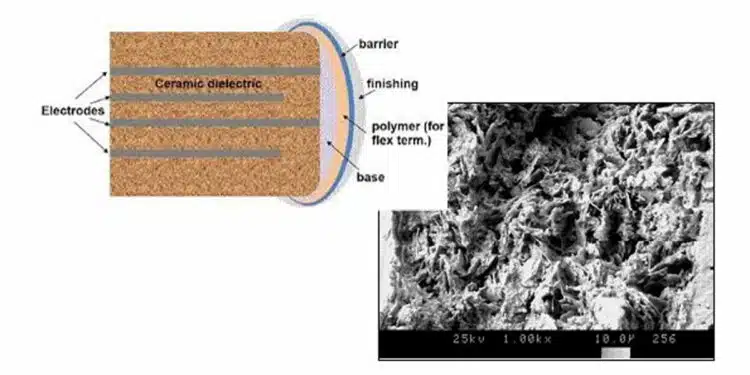This article based on Knowles Precision Devices blog explains capability of MLCC flexible terminations to withstand up to 5mm of bend on AEC-Q200 certified components.
Today, with the continued drive for more technical features in conventional cars and the increasing electrification of the drive train, the challenges facing electronics designers are ever increasing.
Alongside a drive to lower costs and smaller form factors, MLCC ceramic capacitors are being used in ever harsher applications and in ever increasing numbers. This is driving board population density upwards and with it concerns for reliability and particularly the likelihood of mechanical cracking. Thus electronic designers are now demanding flexibility that exceeds the current Automotive Electronic Council bend test specification (AEC-Q200 Rev D June 1, 2010).
The international requirement for bend testing is referred to in several different specifications:
- IEC 60384-1:2001 Fixed capacitors for use in electronic equipment Part 1: Generic Specification section 4.35 Substrate bending test refers to IEC 60068-2-21.
- IEC 60068-2-21: 2006 Environmental testing: Test U: Robustness of Terminations and Integral Mounting Devices. Section 8 test Ue specifies the test required to assess the mechanical robustness of surface mounting device terminations when mounted on a substrate. Test Ue1 specifies the substrate bend test. IEC 60068-2-21 refers to requirements such as deflection and acceptance criteria as being included in the “relevant specification”. Knowles Precision Devices maintains IECQ CECC (International Electrotechnical Commission Quality certification program – CENELEC Electronic Components Committee) product approval and the “relevant specification” is QC 32100-A001:2007
- QC 32100-A001:2007 Table 2 – Periodic Tests defines board flex minimum requirements as:
- Class I C0G/NP0 (1B/CG): All types. Class II X7R (2R1): Y and H only (FlexiCap™).3mm deflection Class I
- 2mm deflection Class II
- X7R (non – FlexiCap™ termination) 1mm deflection
- AEC-Q200-005, Board Flex / Terminal Bond Strength Test.
- Minimum requirements stated in table 2 stress test reference 21: 2mm (min) for all except 3mm for Class I.
Knowles Precision Devices remains the front runner for Flexible termination having introduced the award winning FlexiCap™ technology to the market.
FlexiCap™ polymer termination with its fibrous structure effectively reduces the mechanical stress being exerted onto the ceramic section of the capacitor by approximately 50%. During FlexiCap trials, some 10 million polymer terminated Class II X7R (2R1) capacitors were supplied to customers for evaluation. The applications targeted were those known to have a long history of problems due to capacitor cracking. During the course of these trials, not a single part was identified to have failed as a result of chip fracture.
AEC-Q200 certified components terminated with FlexiCap™ have a higher resistance to mechanical cracking meeting the demand by electronic design engineers for components that far exceed the minimum industry standard for flexibility, enabling Knowles Precision Devices to offer a guaranteed 5mm bend test deflection on AEC-Q200 components exceeding all of the requirements touched on above.































